Though we don’t set off fireworks at Brooks Camp for the Fourth of July, bear viewing at the falls provides an equally interesting display. This year, I decided to celebrate Independence Day with the latter (and more NPS-approved) option, with the hopes of retaining my golden badge and flat hat privileges. From 10 p.m. to 7 a.m. June 15 to August 15, the platforms and boardwalks at Brooks Falls are closed. In order to better understand how bears use the falls when no humans are present, I assisted Brooks Camp’s bear monitor, Leslie Skora, with an overnight monitoring session from 10:30 p.m. - 12:30 a.m., then again from 4 to 7 a.m.
Nighttime monitoring sessions at the falls are one of the many projects run by Leslie (watch the live chat about the bear monitoring program). This summer she conducted five overnight monitoring sessions at the falls, all in July.Because of these monitoring efforts, we know that nighttime closures allow bears that are not tolerant of people (non human-habituated bears) greater access to Brooks Falls. When people occupy the wildlife viewing platform at Brooks Falls, certain bears avoid the area or use the falls differently. The nighttime closure to human activity allows brown bears who are not human-habituated greater access to Brooks Falls.
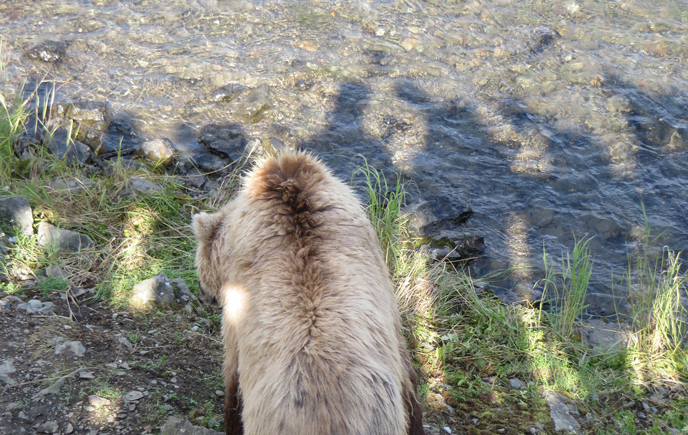
Shadows of bear viewers rain down on a bear. Not all bears are this tolerant of the close proximity of people. Certain bears use the falls differently when people are absent. NPS/T. Anderson
With backpacks full of overnight gear, rangers Leslie, Landis, and I begin our adventure. As we approach the falls, one bold park ranger jokingly asks to see our research permit. Indeed, to stay at the falls after hours, Leslie must obtain a permit proving that her presence is condoned by the park. These permits are not handed out lightly. To obtain a permit, one must prove that the knowledge gained through research will help park officials better manage the area’s resources. Indeed, past research indicates that the presence of people alters how bears use the river. This is the primary reason for closing the falls platform at night—to allow access to more bears.
When we arrive at the platform, we find bear 747 fishing alone in the far pool. Though he makes no visible indication of noticing us, he is no doubt aware of our presence, whether through his keen sense of smell or other acute senses. In the windy Alaskan drizzle, we sit down on the platform and remain quiet and still to maintain a low profile.
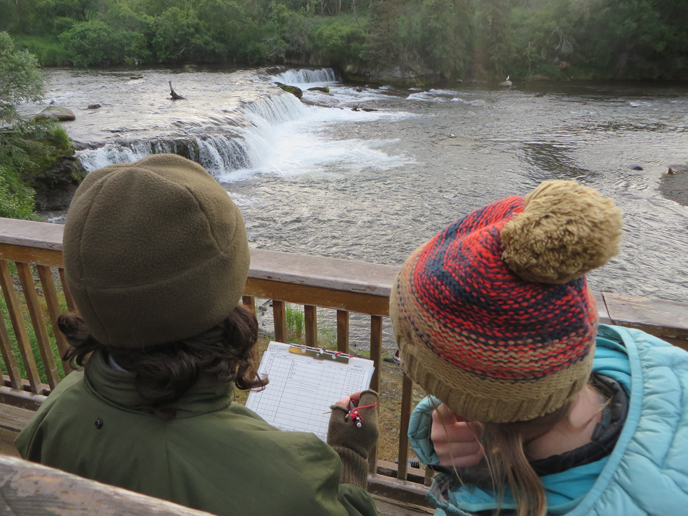 Leslie Skora (left) and Tori Anderson (right) prepare data sheets for an overnight bear monitoring session at Brooks Falls. NPS/T. Anderson.
Leslie Skora (left) and Tori Anderson (right) prepare data sheets for an overnight bear monitoring session at Brooks Falls. NPS/T. Anderson.
After an hour, 747 leaves the falls and bear 755, the aptly named Scare D Bear, comes out to fish. In previous years, 755 has been one of the primary beneficiaries of the nightly falls closure. As a younger bear, 755 shied away from large groups of people. When he did fish during the day, he would fish in the far pool, distancing himself from the crowded viewing platform. Bears like 755 remind us of how humans impact bears, even when we are elevated several feet off the ground. Studies conducted in Brooks Camp have shown that loud disturbances on elevated walkways significantly influence bears’ activity. With a large scale elevated bridge scheduled for completion by the summer of 2017, this is a reality to keep in mind when utilizing elevated infrastructure at Brooks Camp.
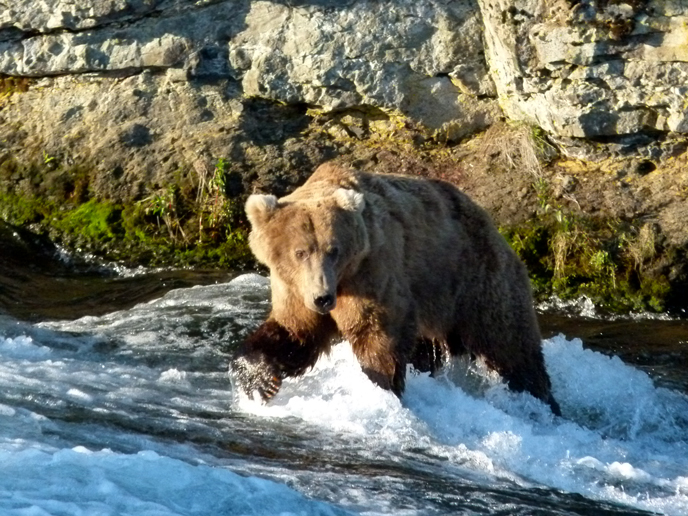 When people are conspicuous, 755 Scare D Bear rarely visits the platform side of Brooks Falls. NPS/L. Skora.
When people are conspicuous, 755 Scare D Bear rarely visits the platform side of Brooks Falls. NPS/L. Skora.
Later that night, bear 128 Grazer comes out to accompany bear 755. Though very human-habituated, 128 still enjoys the opportunities that a quiet falls presents. Our ranger group breaks for a short nap at 12:30 a.m., then returns at 4:00 a.m. for another round of monitoring. Upon our return to the platform, bear 755 is still fishing. At this point, things get a little fuzzy for me (and not because I cuddled with the bears). Somewhere during this second half of the night, I blink and see not 755 but 747. At 7 a.m., we end our session with 747 fishing the far pool and me horizontal on the platform—a technique I defend as necessary for minimizing my impact on the bears.
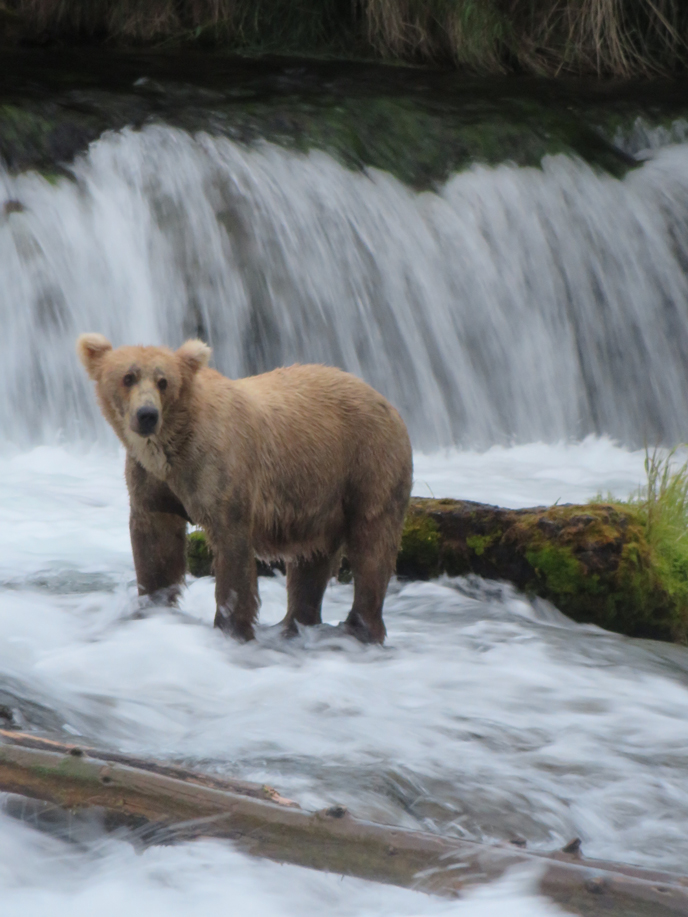 128 Grazer visits the falls regardless of the amount of human activity. NPS/T. Anderson.
128 Grazer visits the falls regardless of the amount of human activity. NPS/T. Anderson.
Though many of the bears at Brooks Camp are habituated to humans, not all are, and the NPS aims to protect all brown bears in the park, regardless of their comfort around humans. Human-habituated bears like128 have spent many seasons in Brooks Camp learning the boundaries that exist between them and humans. Other bears, however, have not had the same experiences and are not as tolerant of humans. Each year, several bears new to Brooks Camp visit the area to take advantage of the plentiful salmon run. Not only must these bears learn to fish at a new stream with several dominant bears around, they also must learn how to act around humans. Some will never learn to tolerate the close proximity of people. These bears may simply avoid using the river when people are present.
Each bear has a unique past that informs its present behavior and tolerance around humans. As visitors in their home, park staff and tourists must respect all types of bears, habituated and non-habituated alike, in order to protect the wild quality of Brooks Camp. The nightly closure at the falls is one way the park manages for this outcome. While the park must constantly evaluate the effectiveness of its management techniques through research such as Ranger Leslie’s overnight bear monitoring sessions, visitors - including park staff - have the ultimate say in the future of Brooks Camp. Visitors’ commitment to park rules and wildlife viewing etiquette will determine the feasibility of Brooks Camp as a bear viewing location in years to come. The park’s management decisions and visitors’ collective actions will determine whether Brooks Camp can be home for all bears, or simply human-habituated bears.
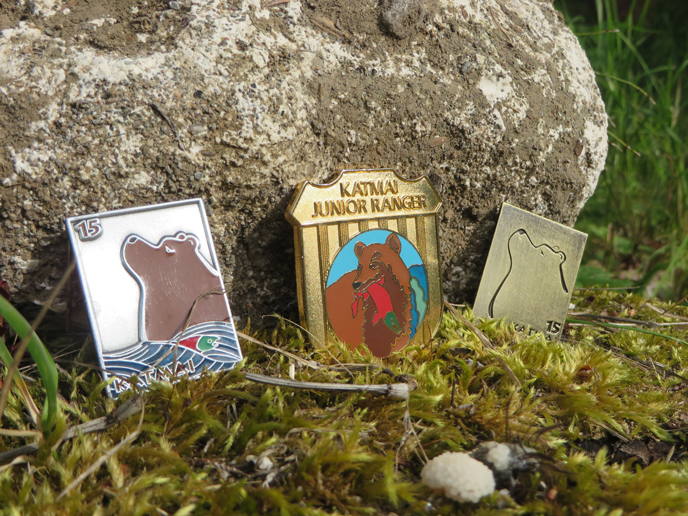 By wearing brown bear booster pin, Katmai junior ranger badge, or a bear etiquette pin you are enlisted to help protect Katmai's bears. NPS/T. Anderson.
By wearing brown bear booster pin, Katmai junior ranger badge, or a bear etiquette pin you are enlisted to help protect Katmai's bears. NPS/T. Anderson.
